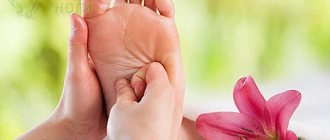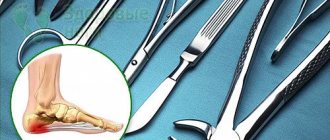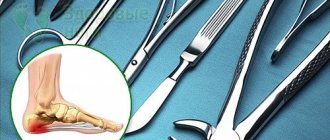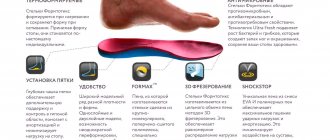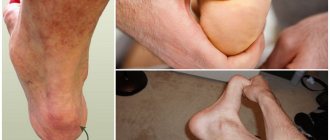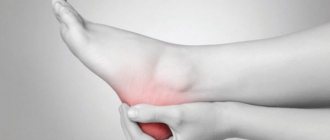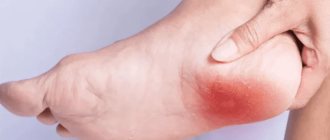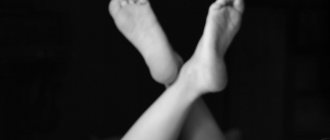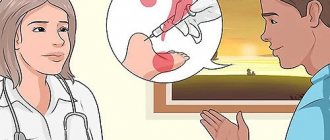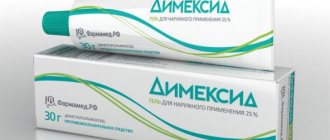- We relieve pain in the heel area in 1-2 sessions
- We use the “gold standard” for heel spur treatment
- We provide an individual approach to each patient
A heel spur (plantar fasciitis, calcific tendinitis of the plantar ligament) is a bone growth in the form of a spike or wedge in the area of the plantar surface of the tubercle of the heel bone. Heel spur belongs to a group of diseases such as enthesopathies - diseases of the attachment of tendons, ligaments, fascia to the bone, in which degenerative and inflammatory changes are observed.
Causes of heel spurs
The main reason for the development of heel spurs is chronic trauma to the plantar aponeurosis as a result of various reasons. Thus, in patients suffering from flat feet, heel spurs are often detected. As a result of the development of a chronic inflammatory process in the plantar fascia, calcium salts are deposited. The main starting processes are:
- excessive stress on the legs
- overweight
- uncomfortable shoes
- frequent microtraumas in this area among athletes
- flat feet
- consequences of heel injuries
How to treat a heel spur
The patient may complain of painful sensations in the heel area due to various pathologies - plantar warts, flat feet, rheumatoid diseases, sprains, problems in the ankle, therefore plantar fasciitis can be treated only after confirmation of the diagnosis.
Treatment for heel spurs must be comprehensive. It is usually conservative. Surgery is used quite rarely.
Basic principles of heel spur treatment
- Reducing pressure on the affected leg
Reducing the load on the foot is achieved through several factors:
- lose weight;
- limit physical activity;
- take a rest during a long walk;
- apply the correct arch fixation;
- avoid walking and exercising on very hard surfaces
In the treatment of heel spurs, the most important thing is to form the correct corset, which optimally supports the muscles and ligaments of the foot. This is achieved with the help of shoes and all kinds of orthoses.
- the right shoes - first of all, the doctor will suggest choosing orthopedic shoes and giving up high heels;
- taping - special tapes-plasters support muscles and help relieve swelling; It is better to use them after gymnastics to strengthen the fascia;
- canes, crutches - aids that relieve the load on the foot;
- instep supports and heel pads allow you to remove part of the load from the affected heel and distribute it over the entire foot;
- orthoses - boot-shaped corsets stretch the fascia, fix it at an angle of 90 degrees and promote its restoration during sleep;
- custom insoles are a good alternative to orthopedic shoes; made taking into account the characteristics of problem areas of the foot, they significantly reduce the load on the legs; Some insoles have special indentations in the spur area, which reduces pain and makes walking easier for the patient.
Shoes, insoles, and arch supports help relieve excessive stress on the feet, carefully support the arch of the foot, and improve blood circulation. The European Center for Orthopedics and Pain Therapy employs first-class specialists. They will help identify foot problems using DIERS diagnostics, if necessary, recommend a new way to solve the problem using kinesio taping, and offer unique orthopedic insoles from the world famous company FormThotics. Every centimeter of these insoles has a targeted function to strengthen the arch of a particular patient’s foot. Doctors will teach patients how to properly unload the plantar aponeurosis and recommend special devices for this purpose on an individual basis.
- Drug therapy
The purpose of the medications is to reduce pain, relieve swelling and stop the inflammatory process. For this purpose it is prescribed
- anti-inflammatory drugs;
- analgesics
Medicines can be prescribed in tablets, but they are often combined with ointments and topical rubs. By rubbing the medicine into the affected area, the patient alleviates his condition. For intense pain, a course of injections may be offered. At the European Center for Orthopedics and Pain Therapy, preference is given to methods that do not temporarily relieve the pain effect, but enhance microcirculation in the affected tissue, increase blood flow and lymph flow. These methods include physiotherapy.
- Physiotherapy
Physiotherapeutic procedures are an effective measure in the fight against heel spurs. In this article we will talk about the most common technologies that have proven themselves in the fight against plantar fasciitis:
- ultrasound – intense and powerful ultrasound radiation activates metabolic processes in tissues and reduces pain; During the procedure, painful areas on the legs are heated; The session takes from 10 to 15 minutes, it is painless, but has contraindications - pregnancy, hypotension, arrhythmias, infectious diseases in the acute period, with thrombophlebitis.
- laser - a thin laser beam aimed at a sore spot has a powerful effect on soft tissues, redox processes are activated, and inflammation subsides.
- magnetic therapy – an electromagnetic field affects the problem area of the foot; the magnetic field dilates blood vessels, enhances lymph circulation, thanks to the session, tissues are actively saturated with oxygen, inflammation decreases, pain disappears;
- UHF - alternating high-frequency current dilates blood vessels, enhances metabolism, relieves inflammation; this method has proven its effectiveness over many years; a course of sessions will help cope with the disease in 1-15 sessions.
- electrophoresis - the necessary medicine penetrates into the diseased area under the influence of a weak electric current; the doctor adjusts the drug administration regimen depending on the result of therapy;
- balneotherapy - taking therapeutic baths is indicated in the course; their duration is up to 10-15 minutes, after such relaxing procedures you need to lie down and give your feet rest;
- shock wave therapy is a unique new technology, it gets rid of salt deposits and eliminates osteophyte; the device releases sound waves of a certain purity, which, passing through the skin and muscles, reach the affected bone and subject pathological growths to destruction;
- nuclear magnetic resonance therapy (MBST) is a modern technique that gives excellent results in pathological changes in the skeletal system of a degenerative-dystrophic nature; the advantage of the technology is high efficiency;
- cryotherapy - cryoanalgesia and local cooling can replace a scalpel in some cases, although the session lasts only 1-2 minutes
- Exercise therapy
At the initial manifestations of the disease, orthopedists recommend regular physical therapy. A special set of exercises is aimed at stretching the ligaments of the longitudinal arch of the foot and strengthening the plantar fascia. Exercises are best done in the morning. The doctor prescribes the exercises individually, but they are based on one goal - strengthening and stretching the long ligament of the foot:
- stand facing the wall, rest your palms on it, place the sore leg behind the healthy one in one line, carefully sit down, bending your legs at the knee joint; if pain occurs, stop for a few seconds and return to the starting position;
- place a tennis ball, bottle or other round object under the sore foot and roll it clockwise and counterclockwise; if pain occurs, you can fill the container with cold water, which will alleviate the condition;
- Place your right leg on the knee of your left leg, make circular movements in the ankle joint, change legs
Before exercise, you need to warm up your joints. All exercises should not cause severe pain. In this case, they must be stopped immediately. If you experience discomfort during exercise, it is advisable to reduce the load. Each exercise must be repeated 7-10 times. Exercise therapy is not prescribed in the acute period.
- Massage
Doctors recommend massaging the entire foot, but you can massage only the sole. It is better to have a massage from a professional massage therapist. But, if this is not possible, you can do it yourself using mechanical massagers. At the very beginning of the procedure, it is necessary to make rubbing or stroking movements. The heel, sole, and toes are massaged separately. Tapping and kneading movements are effective. All self-massage techniques must be performed 5-6 times and change legs. It is advisable to take a warm bath with soda before the massage, and after the massage lie quietly for 3-5 minutes with your legs extended and elevated. It is advisable to wear warm woolen socks on your feet.
- Surgical intervention
Surgery for plantar fasciitis is resorted to in extreme cases, since it cannot get rid of the spur forever. The cause of heel spurs cannot be removed surgically, so relapses occur after surgery.
Treatment of heel spurs at the European Center for Orthopedics and Pain Therapy using MBST therapy
Doctors at the European Center for Orthopedics and Pain Therapy have extensive experience in the treatment of plantar fasciitis. The center has unique, state-of-the-art equipment that will help get rid of heel spurs quickly and reliably without surgery. The Center's highly qualified specialists are proficient in innovative technologies that have proven themselves in Germany and other countries where medicine is at the highest level.
Thus, clinical studies have proven that magnetic resonance therapy (MBST) for bone growths is highly effective. But compared to surgical removal of exostosis, the MBST procedure does not require the use of anesthesia, the therapy is non-contact, which ensures rapid rehabilitation and reduces the risk of infection to zero. In addition, MBST therapy can be used as an independent treatment or in combination with other procedures.
Undoubted advantages of MBST therapy
- proven effectiveness;
- There are practically no contraindications;
- can be used in patients of any age;
- no side risks;
- painlessness;
- absolute safety;
- elimination of pain and swelling;
- you can do without taking medications that usually have side effects;
- no allergies;
- possibility of treating other musculoskeletal problems
Nuclear magnetic resonance therapy has helped many patients diagnosed with plantar fasciitis and restored a healthy and easy gait.
Symptoms
The main complaint that patients have with a heel spur is a burning pain when placing weight on the heel; a feeling of a “nail” in the heel is the most common symptom of a heel spur. Lameness often develops. A heel spur significantly affects the patient’s quality of life, especially if it occurs on both legs at once. In this case, if both feet hurt, the patient simply cannot move normally; the only option is to walk on his toes. The main danger of a heel spur lies precisely in the severe pain and limitation of the motor activity of patients against this background.
Advantages
Blocking the spur on the heel provides a number of advantages compared to other methods of drug therapy:
- The blockade is effective when other methods of pain relief fail.
- The maximum amount of the drug accumulates at the site of inflammation, and the side effects on the body are minimal.
- A small amount of the drug is enough to relieve pain.
- The pain is relieved quickly, and the therapeutic effect is long-lasting.
- The procedure takes a few minutes.
Treatment
Treatment for heel spurs is conservative in most cases. It is worth noting that surgical treatment methods, according to foreign authors, have proven to be low in effectiveness. Drug and physiotherapeutic treatment of heel spurs is aimed at relieving inflammation of the tissues around the heel tubercle and increasing the elasticity of the ligaments. In this case, even a bone growth will not cause pain when walking. Doctors at the Bone Clinic will select an individual treatment program for each patient.
It is worth noting that for a long time, the treatment of such a group of diseases as enthesopathies, namely heel spurs, was quite problematic. With the advent of the modern method of extracorporeal shock wave therapy (ESWT), treatment of spurs has ceased to be a problem! Currently, ESWT is the gold standard for the treatment of enthesopathies throughout the world. It has been proven that ESWT is more effective than surgery, while being safe and painless. Such unique equipment is available only in one medical center in our republic - the Bone Clinic.
1.What are “corns”?
“Calls” are dry calluses on the feet, which are dense, keratinized areas of skin. While protecting the soft tissues of the legs from mechanical stress, they nevertheless cause considerable concern and can cause more severe complications. In addition, needless to say, the delicate smooth skin of the feet is aesthetically more attractive than rough, cracked soles...
Most often, the skin on the feet thickens and dries out at the base of the toes and along the outer contour of the heel. The surface layer of the epidermis dies, forming a rough, yellowish crust. In these places, the sensitivity of the foot is reduced. Further mechanical stress during walking can lead to the appearance of cracks in the corns. If the hardened areas are not removed, wearing shoes becomes quite painful. In places of greatest growth and keratinization of the skin, constant discomfort, pain, and burning are felt.
Cracks can deepen into soft tissue and bleed.
A must read! Help with treatment and hospitalization!
The treatment program for this disease at the Bone Clinic may include:
Shock wave therapy
More details
PRP therapy
More details
Acupuncture administration of ozone
More details
Teraquantum therapy
More details
Interference therapy
More details
2.Why do corns form?
We can definitely say that the predisposition to the formation of corns varies from person to person. For each person, a whole complex of external and internal factors is important here. We have to come to terms with those of them that we are not able to completely change:
- The structure of the foot, abnormalities in the development of the legs (flat feet, bone growths);
- Features of the skin;
- Distribution of subcutaneous adipose tissue;
- Condition of the vascular system of the legs;
- Metabolism, individual characteristics of metabolism;
- Hormonal background;
- Chronic diseases and anamnesis.
If you notice a tendency to form corns, first of all, you need to pay attention to what could cause increased stress on the feet. A number of such reasons are varied and can be corrected:
- Occupation that involves walking or standing during the day;
- Lifestyle, hobbies and activity (running, dancing, ballet);
- Tendency to obesity, excess weight;
- Low-fat diet, vegetarianism;
- Avitaminosis;
- Tight shoes, predominantly wearing high-heeled shoes;
- Fungal diseases of the feet.
Visit our Dermatology page
3.Prevention of corns
For many people, the problem of corns is chronic.
Folk remedies, cosmetic procedures and foot care bring only temporary relief. In this case, it is worth considering the problem as chronic and approaching treatment comprehensively.
The constant formation of corns always indicates a serious imbalance in the body or disturbances in lifestyle. In this case, the problem should be solved in two ways - along with cosmetic methods, it is necessary to focus on identifying the reasons that cause increased keratinization of the skin of the feet.
Seeking medical help often includes consultations with a dermatologist, orthopedist, and endocrinologist. A systematic approach, the study of anamnesis and lifestyle make it possible to identify the main factors of increased death of epidermal cells. If a connection between corns and health problems is discovered, treatment of the underlying disease always helps to solve the problem with the skin of the feet. The effectiveness of the therapy can be accelerated by local procedures aimed at eliminating skin growths and further prevention:
- Anti-callus plasters;
- Keratolytic cream;
- Hot foot baths;
- Natural and synthetic pumice;
- Softening cream with medicinal herbs.
About our clinic Chistye Prudy metro station Medintercom page!
